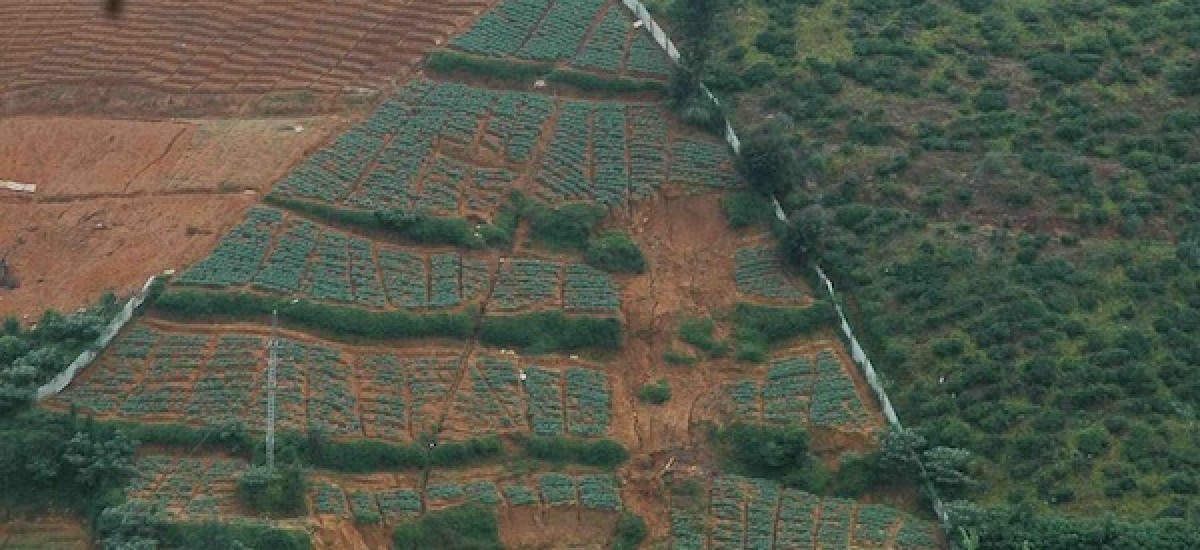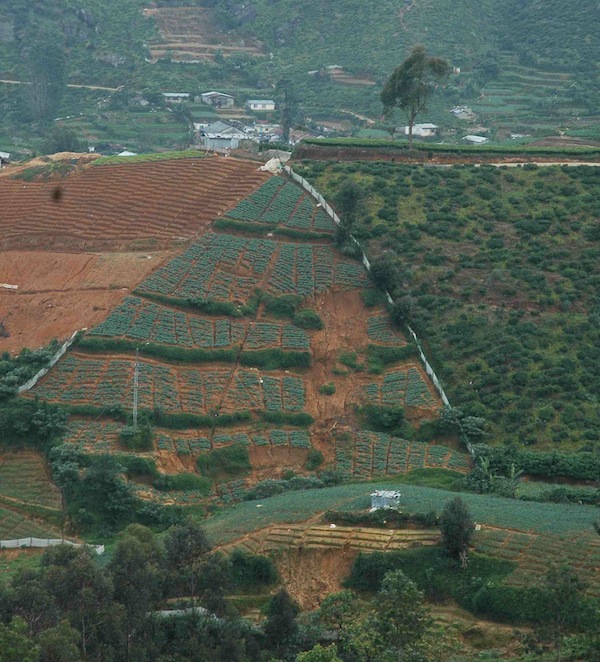Read Part 1 here.
The effect of clearing the forests and allowing erosion of the soil, especially on the mountain areas became obvious to scientists who visited this country. Dr. Strange, an agricultural expert to Ceylon made this observation in 1909 with respect to the clearing of the mountain forests:
“It would not have been necessary to notice here the matter of soil denudation, did it not affect irrigation and water supply. The result of stripping the soil is to make the springs on tea states dry up quickly; to diminish the fair-weather flow of streams and to increase their storm flow (whereby temporary irrigation weirs are carried away) and to choke with silt the beds of the streams and the irrigation channels led from them. It is also said to reduce the fertilizing property of the water, as there is now less leaf mould in solution. Even paddy fields have been ruined by sandy deposits laid on them. When tanks lie in the course of streams thus affected, the rate of their silting-up will rapidly increase and their storage capacity will greatly diminish. Even the large rivers, such as the Kelani, have had their section diminished by soil debris, so that for this reason, as well as on account of the greater run-off produced by the clearance of the forest entailed by the establishment of estate plantations, the flood waters cannot be contained in the river channel, but are spread over the riparian land and do much damage. If such damage affected only a small area it would not, of course, matter much, but it has to be remembered that the tea and rubber estates are on the hills, and uplands, which are the principal sources of supply to rivers draining two-thirds of the Island; the effect of denudation it thus widespread.”
The importance of retaining and building the soil in the watershed areas feeding the hydroelectric system has been pointed out over and over since these comments. Yet, reservoirs are constructed without any consideration of the silt loads of the eroding watershed or any plan to revegetate them.
Development and modern agriculture has begun to impact our soils far more today than times past. Soil compaction brought about by the use of heavy machinery and vegetation removal is common throughout the land. Compacted soils cannot absorb rainwater as before and run off with accompanying floods are the result. Acidification of the soil is a phenomenon that accompanies application of chemical fertilizers and salinization is a clear danger when surface irrigation, as with industrial agriculture, begins. Urbanization and road construction now seals a sizable area of soil.
Vegetation is critical because, good soils generated are by plants roots and microorganisms, which in turn create a ecosystem that can clean, process and hold, considerable amounts of water. They create pores which take in water, and will keep doing so until they are full, after which they transmit water through, these pores. Some of this water will steadily drain through the soil into waterways and streams and maintain dry weather flow at times of no rain. But in a healthy soil, much of it will be retained, away from the influence of gravity, for use of plants and other organisms to contribute to land productivity and soil health.
When soil looses its tree cover and the input of organic matter to feed the living soil goes down, it looses its cohesive strength. The loss of cohesive strength accelerates erosive processes and is brought about through the loss of soil binding agents both macroscopically and microscopically created. The macroscopic binding agents are the roots of plants and plant compounds. The microscopic agents are the bacterial gums, polysaccharides and humates. With an increase of chemical reliant intensive farming there is a corresponding loss of soil microorganisms that provide cohesive strength to soils. The result is, erosion in wet weather and an increase of dust during dry weather.
Soils also store vast amounts of carbon, more than twice as much as in vegetation or the atmosphere. They do this by respiration processes, which use the energy fixed by photosynthetic activity, to create very long-lived soil carbon compounds synthesis such as humates. The more undisturbed the soil the more carbon it can accumulate and hold. Here, the effective rate of sequestering is dependent on the nature of the soil that it is being produced in.
Thus forested areas or areas with dynamic vegetation create the best soils in nature. Agriculture, that is sensitive to the needs of soil, such as biodynamic, organic and many traditional methods create very good soils in human environments. It was an interdigitization of these two elements that sustained long-lived agricultural societies the world over.
However the current trend in ‘land development’ is to reduce tree and forest cover and degrade the soil ecosystem. The current trend in agricultural development is to add chemicals that destroy the soil’s natural productivity and create energy addicted production systems.
This trend if allowed to continue will impact not only the present population but will also compromise the health and security of future generations of Sri Lankans. Not only do we need to become acutely aware of the value of clean water, we need to work nationally at maintaining soils and soil quality. Our ancestors, conserved the mountain forests and soils and gained dry weather water flow for the lowlands, the productivity of that agriculture is history. The wisdom of our ancestors. Should be recognized and utilized in developing responses to the dangerous future before us with the extreme climate changes expected. Climate patterns have been known to be regular will change dramatically . Rare climate events that brought droughts and famines over the centuries are expected to increase in frequency , because we have accelerated this process. We need to develop coping mechanisms rapidly.
We need to develop high biomass, diverse, low external input dependent, production systems as a critical development goal. We need to place a value on the environmental services that they provide. Environmental services are being recognized. by many nations today. Some nations are already including them in their national budgeting.
Some examples are :
- Carbon sequestration
- Oxygen generation
- Water protection
- Water cleansing
- Cloud generation
- Rainfall incrimentation
- Biodiversity protection
- Food security
- Erosion control
The basis of most these services is the soil. For without a good living soil, the ecosystem above cannot develop. Tragically, it is true that the current push in agriculture to be reliant on chemicals and fossil energy or production will not only destroy the little life we have in our soils, it will also tie the price of food to the price of fossil energy. No one who claims concern for this land, should be ignorant of what the land represents.
With a better knowledge of our land, with a deeper commitment to the future, we might be able to engage in a national conversation on the state of our land and our level of concern for it. In gaining more knowledge, we might hear the cry of this land, of our nation…..and respond!


